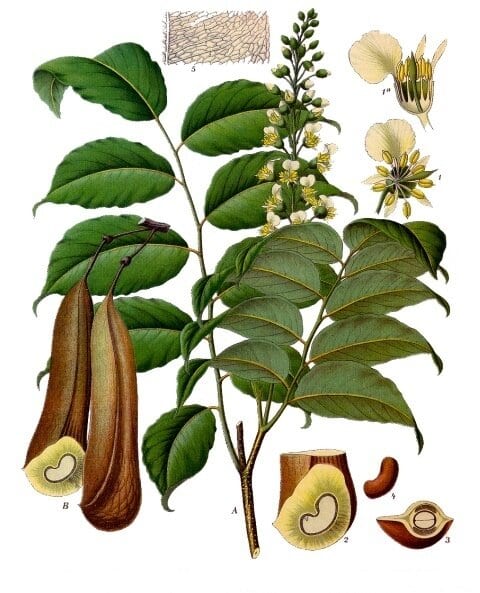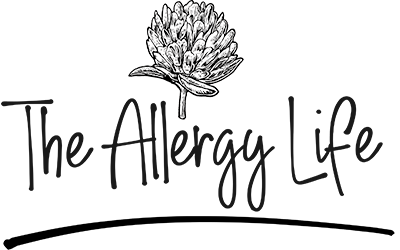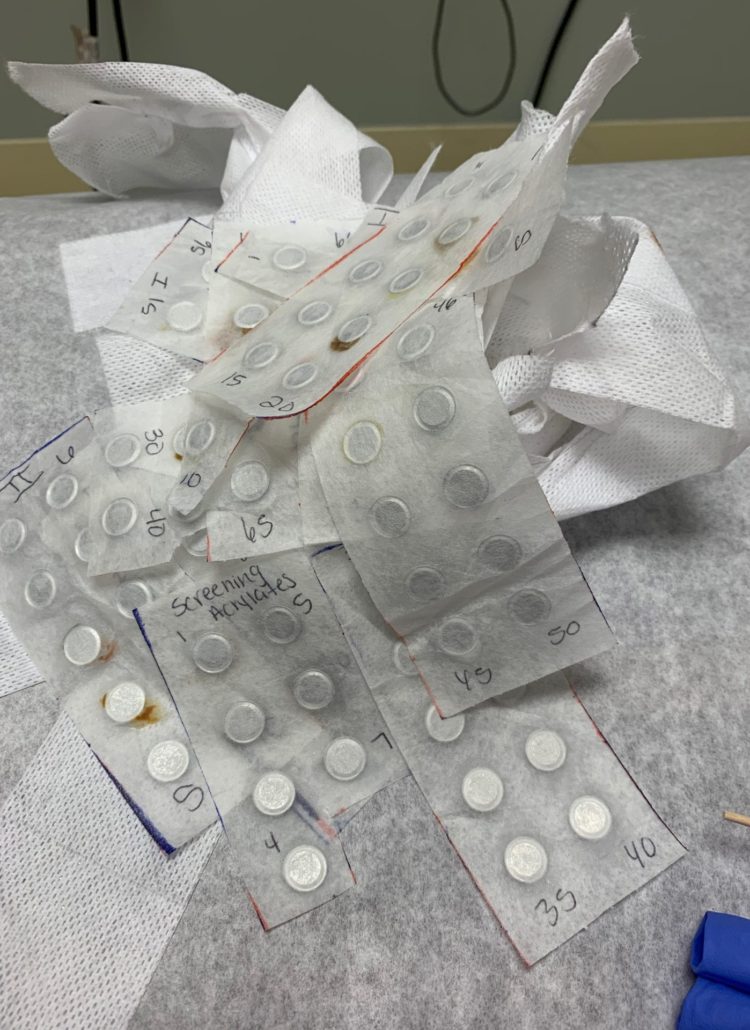
Balsam of Peru allergy
A Balsam of Peru Allergic Contact Dermatitis allergy can be one of the most complicated ACD allergies to understand and manage. You’ll find a brief introduction to the Balsam of Peru allergy and Balsam of Peru ingredient lists in this post. Other pages on The Allergy Life contain wonderful research as well. There is wonderful information available on the Dermatitis Academy website. This website is managed by patch test pediatric dermatologist Dr. Sharon Jacob. Dr. Jacob maintains a wealth of information there, and we are lucky to have her practice in the United States.
Balsam of Peru: Past and Future
You will find a summary of a medical journal article I’ve read written by a group of patch test specialists. In 2013, this article was written and is the most detailed account of Balsam of Peru allergy I have found. Reprinting medical articles is tricky, and I did request permission to print it here, but I that has not been given. As a result, I did my best to summarize it for you until that permission is given. The article, Balsam of Peru: Past and Future, was written in 2013.
Above all, the most important thing is not to get discouraged. Fighting Balsam of Peru allergy is complex, but it is possible to live a more reaction-free life with careful attention to foods and products. In addition, Balsam of Peru is one of the most commonly diagnosed contact allergens in the US. I am hopeful that we can live a reaction-free life with this information! For one thing, I have seen many testimonies of complete remission of this allergy once avoidance is followed. A Balsam of Peru allergy list is listed below and will help you follow a Balsam of Peru Avoidance Diet.

Balsam of Peru Avoidance Diet
*It’s important to note that a Balsam of Peru avoidance diet where you avoid all balsam of Peru chemical constituents could be the missing link in treating your allergic contact dermatitis. Surprisingly, many with ACD to Balsam of Peru are unaware that eliminating foods could help their dermatitis. While it is a challenging undertaking, living reaction-free days is a true gift. I hope that by breaking this allergy down for you, you’ll have the tools you need to live more reaction-free days.*
Balsam of Peru is tree sap. Myroxylon Pereirae, the medical term for Balsam of Peru, is a thick sap-like fluid secreted from the tree Myroxylon Balsamum Pereirae. It has a potent vanilla/cinnamon odor. BofP (Balsam of Peru) has a mixture of contact allergens, including cinnamein oils (eugenol, cinnamates, and vanillin); benzoic acid derivatives (benzoates); ferulic acid; and coniferin (coniferyl alcohol). These chemicals are often found in food, spices and flavorings, cosmetics, fragrances, and medicine.
For many of us with Balsam of Peru allergy, simply avoiding fragrance ingredients in products is not enough to live a reaction-free lifestyle and stop Balsam of Peru Allergy Symptoms. We have to live a life avoiding food and drinks that can trigger systemic contact dermatitis – flares due to ingestion of these constituents.
Exclude these balsam of Peru foods
A diet excluding these BofP-containing foods is a great tool for living a reaction-free lifestyle. An avoidance diet includes excluding foods containing BofP constituents like cinnamates, vanillin, benzoic acid, and eugenol. These are found in citrus fruits, tomatoes, spices, condiments, sweets, and liquor.
Balsam of Peru allergy is a cross-reactor to Fragrance Mix I allergies. If you’re patch-test-positive to Fragrance Mix I and Balsam of Peru, be cautious to avoid these compounds that show up for both. Fragrance Mix I and Balsam of Peru: Eugenol, Isoeugenol, and Cinnamic Aldehyde (Benzoates).
Patch testing for specific components of Balsam of Peru can prove helpful as some of us allergic to Balsam of Peru are only allergic to one subgroup (for example, only benzoates or eugenol). Testing for each subgroup could open up a wide range of ingredients you could add back into your daily life. Ask your patch test specialist if individual subgroup testing makes sense for you.
For a copy of the handout many patch test patients receive, you can find it here Balsam of Peru Handout
Balsam of Peru Ingredient Lists
Balsam of Peru is often listed as these ingredients when found in cosmetic or skin and hair products:
| •Cinnamic or cinnamylic acid; 3-phenyl- 2-propenoic acid; 3-phenylacrylic acid |
| • Cinnamal or cinnamic aldehyde; cassia aldehyde; 3-phenyl-2-propenal |
| • Cinnamic or cinnamyl alcohol; 3-phenyl-2-propenol; 3-phenyl allyl alcohol |
| • Methyl cinnamate or methyl cinnamylate; cinnamic acid methyl ester; methyl 3-phenylpropionate |
| • Benzyl cinnamate or cinnamein; cinnamic acid benzyl ester; phenyl- methyl 3-phenyl-2-propenoate |
| • Vanillin or vanillic aldehyde; vanillaldehyde; 2-methoxy-4-formylphenol |
| • Eugenol or allylguaiacol; 2-methoxy-4-(2- propenyl)phenol; 2-methoxy-4-allylphenol |
| • Cinnamyl cinnamate or styracin; 3-phenylallyl cinnamate |
Other names for Balsam of Peru Ingredient
| • Benzoic alcohol • Benzyl benzoate and other benzoates • Benzyl acetate • Benzoic acid • Benzaldehyde • Benzyl salicylate |
| • Cinnamic aldehyde • Citrus peel • Coniferyl alcohols • Coumarin |
| • Farnesol • Isoeugenol • Nerolidol • Resinous substances • Tea Tree Oil |
Balsam of Peru: Past and Present article
The below information is detailed in an American Contact Dermatitis Society article. Balsam of Peru is made up of several subgroups. The patch test performed for the balsam of Peru allergy combines all of these subgroups together. Discovering which subgroup you’re allergic to can help you with avoidance.
Eugenol Subgroup
Eugenol/Isoeugenol is found in almost all foods containing BofP, with a few exceptions. Those only allergic to Eugenol may not actually be allergic to citrus fruits, wine, or real vanilla (vanillin). People allergic to these chemical constituents will want to avoid cinnamon and artificial vanilla (eugenol can be added). Basil and Bay leaves are a significant source of eugenol exposure. Curry can also be a significant source of trouble for this subgroup. Curry can have nutmeg and cinnamon. Avoid cloves, dill, allspice, and mace.
Eugenol Avoid List
| Sweet Food | Chocolate | Synthetic Vanilla |
| Cola | Tomato | Tomato |
| Cinnamon | Cloves | Nutmeg/Mace |
| Dill | Allspice | Anise |
| Bay Leaves & Basil | Curry Powder | Spiced Condiments |
| Pickles | Pate | Perfumed/Spiced Tea and Tobacco |
| Beer | Gin | Whiskey, Spiced Liquor |
Vanillin Subgroup
Vanillin is a phenolic aldehyde. Its functional groups include aldehyde, hydroxyl, and ether. Vanillin is the primary component of the vanilla bean extract and is found in foods that contain vanilla, cloves, and those flavored with vanillin. Some examples include chocolate (vanilla), curry (cloves), vermouth (clove), cola (vanilla), wine (vanillin and pickled items (cloves). Surprisingly tomato, cinnamon, cassia, nutmeg, mace, allspice, bay leaves, basil, and dill do not appear to contain vanillin and may actually be tolerated by a person with a vanillin-only contact dermatitis allergy.
Vanillin Avoid List
| Sweet Food | Chocolate | Vanilla |
| Synthetic Vanilla | Cola | Cloves |
| Curry Powder | Pickles | Pate |
| Perfumed/Spiced Tea | Wine | Vermouth |
| Asparagus | Tobacco |
Cinnamate Subgroup
Cinnamic Acid is obtained from the oil of cinnamon. It is also found in shea butter. Cinnamic acid has a honey-like odor, and its ester, ethyl cinnamate, are flavor components of the essential oil of cinnamon, where cinnamaldehyde is the primary chemical constituent. Those only allergic to the cinnamate subgroup of BofP allergy may only need to avoid the cinnamate avoid list.
Cinnamate Avoid List
| Citrus Peel | Sweet Food | Chocolate |
| Cola | Tomato | Cinnamon |
| Casia | Anise | Bay Leaves and Basil |
| Curry Powder | Spiced Condiments | Pickles |
| Pate | Perfumed/Spiced Tea | Tobacco |
| Wine | Beer | Gin |
| Vermouth | Spiced Liquors |
Benzoate Subgroup
Benzoic Acid naturally occurs in vanilla, cinnamon, anise, and cassia (Chinese cinnamon) as well as foods that contain these spices, including, but not limited to: chocolate, cola, spiced condiments, pickles, and vermouth. Also, benzoates naturally occur in milk products, fruits, potatoes, beans, soy, nuts, cereals, and honey.
The challenge is we do not know the exact threshold of benzoates to induce a systemic contact allergy, and the number of benzoates contained naturally in foods is far lower than its preservative, such as sodium benzoate. An exception to this is the fruit in the Vaccinium genus species like cranberry, blueberry, and huckleberry, which naturally have high levels of benzoic acid comparable to preservatives levels.
Eliminating Benzoic Acid for me was a very important step in controlling my Balsam of Peru allergy.
Benzoate Food Avoid List
| Chocolate | Chocolate | Cola |
| Cinnamon | Cassia | Anise |
| Spiced Condiments | Pickles | Pate |
| Vermouth |
Ferulic Acid Subgroup
Ferulic Acid is found in many plant’s cell walls, and its derivatives are numerous in vegetables like tomato and asparagus, citrus fruits, apples, and pineapples. It is also a component of wheat and rye.
Ferulic Acid Food Avoid List
| Citrus Peel | Cola | Tomato |
| Dill | Pickles | Pate |
| Wine | Gin | Vermouth |
| Whiskey | Wheat | Rye |
Coniferin Subgroup
Coniferyl alcohol is found in asparagus, whiskey, and beets and is a fermentation product of brewer’s yeast, so avoiding beer and leavened bakery products may prove helpful.
Coniferin Food Avoid List
| Wine | Whiskey |
| Beets | Asparagus |
| Brewer’s Yeast | Beer |
Avoidance Diet and Controlling Allergy
Avoiding the foods above can go a long way in controlling your Balsam of Peru allergy. It can be the missing link in becoming reaction-free for some. Although this list seems as if you can no longer eat anything, focus on the things you can eat reaction-free. I have gone so far as to eliminate Tea from my diet. Protein without spice and some vegetables are a great way to start. I also always have luck with my Balsam of Peru Avoidance Smoothie.
Keeping a food journal can prove extremely helpful. After following a complete avoidance diet for several months, you may add one food back at a time. Experts believe introducing one food at a time and eaten every day for 3-5 days is the best way to test tolerance. If after a week with the new food you do not react, you may introduce another. Good luck!





Dee says
Such a complete wealth of information for those of us impacted by a Balsam of Peru allergy. This is a tough allergy to manage, I’ve been dealing with it for so long now. Thank you so much for condensing this information into one spot. I am always looking for new information on this topic. Thank You Dannyelle!
Rowan Poots says
Hi
I’ve just been patch tested and diagnosed. My hands have been a mess for over a year! And I’m a guitarist and instrument builder! My diagnosis leans toward contact, primarily, and the benzoic/benzyl group. I’ve been instructed to avoid any contact, but not required to adjust diet as yet. I can’t find hair/body products! Any help is great. I’m in Canada [email protected] HELP!
Keturah B says
Hello,
I have found the product called VaniCream. They do a whole line of beauty and hygiene that is safe for BoP Allergy sufferers. I recommend their hair products.
Steve Swiacki says
I have been suffering for well over a year with itching and recently had the truetest done with BOP coming out on top. 6 weeks, removing all my favorite cooking spices, veggies etc…bummer..will check back then.
thank you for putting this together.
Lisa says
I can not clear up the swelling that occurs under my bottom lip. I have tried various creams. The last prescript was Elidel which is very expensive and has side effects. After reading all the horror stories from people with this allergen I guess I am lucky. I have no itching, blisters etc., just a slight swelling under the lip. Can this be cleared up with just diet?
April Neubauer says
Thank you so much! This is one of the best resources I have found. Due to lack of good medical advice for allergies, most of my information was gained as a result of trial and error….a long and painful process. I really appreciate a good source of information to help me on my path to live with a severe BOP allergy. THANK YOU!!
Holly says
Wow! I love the way you have broken this down. It is a very tough allergy to manage. I’m still working on it after many years of being diagnosed. Thanks for compiling this research!
Colleen says
What an amazing resource – organized in the most manageable way I’ve been able to find. Thank you! I was just diagnosed from patch testing, but have truly suffered with a terrible palmo plantar rash that has grown over the last 4.5 years. I’ve seen SO many dermatologists and they’ve tried many approaches, but none ever wanted to test for allergies until this last one. I wanted to years ago and was set to begin in April 2020, but that didn’t happen for obvious reasons. I’m thankful that this came to light. It’s sad that many who get labeled psoriasis or eczema, with the “simple” recommendation of going on serious immune suppressants is the quick answer in our broken healthcare system. This, of course, isn’t any easy approach – and some may very well choose a Pharma approach, but it’s nice to understand the source and have a choice, for the sake of our long-term health. I had thoroughly analyzed all my products with very little overlap, but it makes sense now (knowing BOP goes by 15 completely different names). I’m going on all the restrictions now and hoping to see some big changes, but your blog certainly makes it more manageable to cross reference the possibilities. Thank you, thank you!